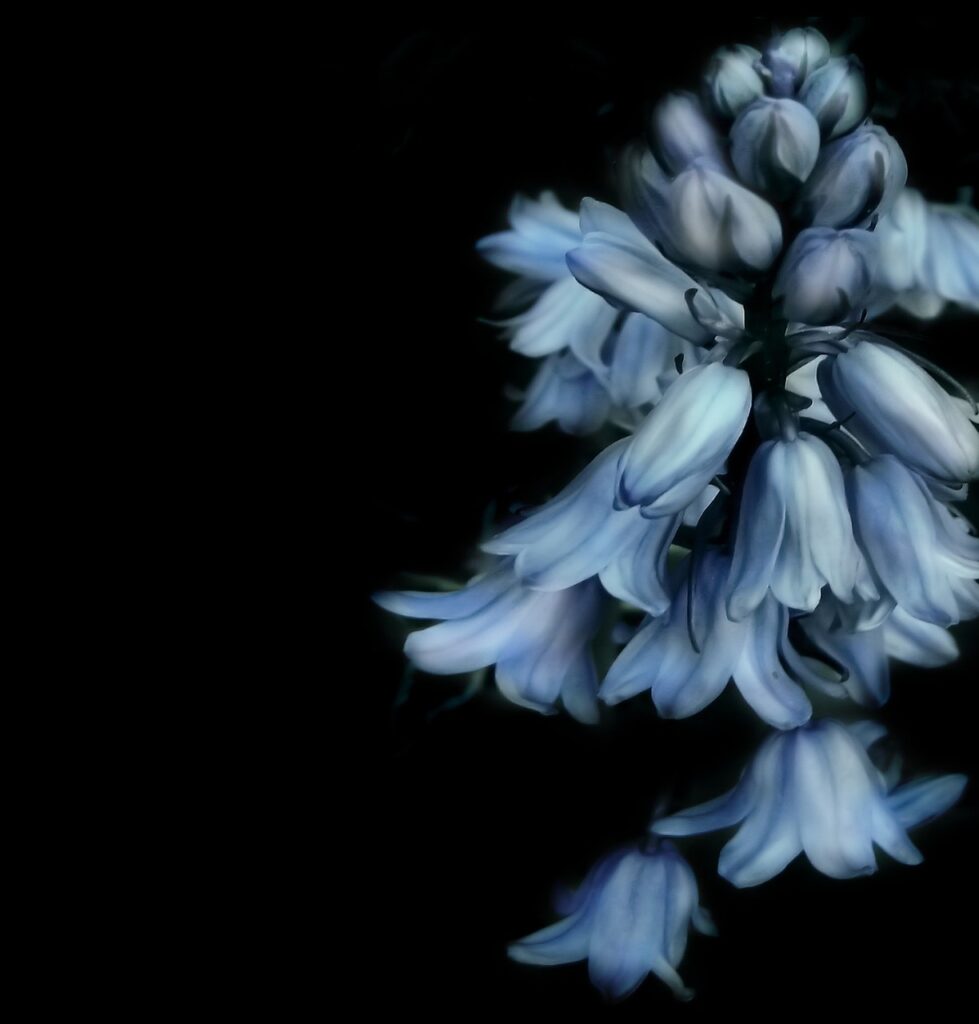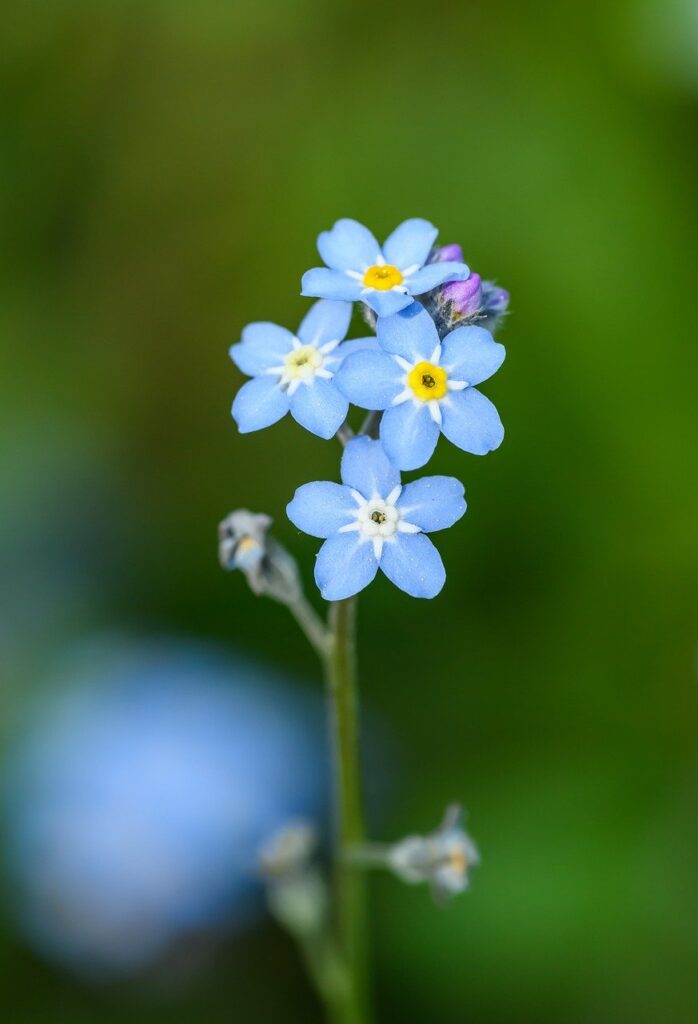
Blue flowers have captured the hearts of gardeners and nature enthusiasts for generations. Their relaxing, serene colors represent serenity, tranquility, and elegance. whether you’re designing a garden or simply enjoying nature’s beauty, knowing the names of some magnificent blue flowers will help you identify and comprehend their significance. in this post, we”ll look at 10 stunning blue flower names that will inspire you to include these lovely plants into your outdoor environments.
1. Bluebell

Bluebells, one of the most popular blue flowers in spring gardens, have a delicate and lovely appearance. The bluebell, Known for its nodding, bell-shaped flowers, grows in clusters and blankets woodlands in pastel blue. Bluebells are native to Europe, and their vivid color and fragrant aroma entice pollinators like bees and butterflies.
Fun Fact: Bluebells are frequently associated with fairies and enchanted woodland worlds in folklore, serving as a symbol of humility and thanks.
2. Forget-me-not

Forget-me-nots are classic blue flower with little, star-shaped petals that evoke melancholy and remembrance. These little flowers are frequently used in bouquets and floral arrangements to represent sincere love memory. They grow in moist, well-drained soil and can be fund in variety of environments, including wildflower meadows and garden borders.
Fun Fact: The name ”forget-me-not” refers to the flower’s metaphorical connotation of never being forgotten. It is also used in numerous cultures to represent eternal love and friendship.
3. Delphinium

Delphinium, often known as larkspur, is one of the most striking blue flowers, with towering spikes covered with bright blue blossoms. Delphiniums, known for their brilliant color and height, are popular ornamental plants in gardens. They bloom from late spring to early summer and come in a variety of blue hues, ranging from pastels to deeper, more vivid tints.
Fun Fact: Delphiniums were once thought to represent a knight’s daring, power, and ambition. They do, however, indicate an open heart and gladness in the floral language.
4. Cornflower

The cornflower is another lovely blue flower with a fascinating history. These colorful bloom, which were once prevalent in European cornfields, are now widely farmed for their beauty. Cornflowers have fringed petals that produce a spiky, star-like look. The deep blue colors is commonly seen in wedding bouquets, representing a happy, long-lasting love.
Fun Fact: Cornflowers were once used to color garments and in herbal treatments. The flower is also historically significant in the military, representing hope and remembering.
5. Morning Glory

Morning glories, with their huge, trumpet-shaped blossoms, make a striking addition to any garden. These vines are known for their deep blue to purple flowers, which bloom in the early morning and fade by the afternoon. They are ideal for trellises, fences, and arbors, where they can quickly expand and cover structures in a sea of blooms.
Fun Fact: Morning glories are named for their ability to blossom early in the day and fade as the sun moves across the sky. In certain cultures, they represent new beginnings and the cyclical aspect of existence.
6. Hydrangea

While hydrangeas come in a variety of colors, gardeners particularly enjoy the blue hydrangea. The color of these rich, spherical clusters of miniature blooms can range from delicate sky blue to deep indigo, depending on the soil pH. Blue hydrangeas thrive in wet, shady conditions and are commonly used in landscaping as focal points or in flower beds.
Fun Fact: The color of a hydrangea’s blossoms varies according to the acidity of the soil. Pink flower grow in alkaline soil, whilst blue flowers grow in acidic soil. Hydrangeas have also been associated with appreciated and understanding.
7. Bachelor’s Button

Bachelor’s button is a wildflower that blooms in gorgeous blue and is closely linked to cornflower. These flowers are commonly grown in gardens due to their bright appearance and capacity to attract pollinators. Their frilled petals and bright blue color make them a striking addition to any landscape.
Fun Fact: Bachelor’s button were named for unmarried men because they were thought to be the flower for a bachelor’s boutonniere. Flowers indicate hope and the desire for good fortune.
8. Lobelia

Lobelia is a low-growing plant with delicate, trailing stalks that bear small, brilliant blue blooms. Because of their cascading growth habit and long bloom time, these lovely blossoms are popular in hanging baskets, window boxes, and containers. Lobelia flourishes in sunny to moderately shaded environments and lends a splash of blue to garden arrangements.
Fun Fact: Lobelia is commonly connected with the ability of healing and protection in herbal therapy. It’s also associated with the concepts of faith and endurance in numerous civilization.
9. Salvia

Salvia, popularly known as sage, is a tough herb that produces spikes of bright blue blooms. The blue salvia cultivar is recognized for its long-lasting blooms that attract hummingbirds and butterflies. These plants thrive in full sun and well-drained soil, making them ideal as garden borders and ornamental plantings.
Fun Fact: Salvia has therapeutic characteristics and has been used in traditional medicine for millennia to treat a number of illness. It also represents and excellent health.
10. Creeping Jenny

While creeping Jenny is most known for its yellow-green foliage, there is also a type with gorgeous blue flowers that bloom from late spring to early summer. This ground cover plant is perfect for creating a carpet of blue flowers in shady garden areas, and its hardiness makes it a popular choice for low-maintenance landscaping.
Fun Fact: Creeping Jenny’s blue flowers are modest, but they offer a delicate and lovely touch to gardens. The plant represents rebirth and rejuvenation, and is frequently used to symbolize new beginnings or growth.
Why Are Blue Flowers So Special?
The appeal of blue flowers extends beyond their stunning appearance. Blue is a relaxing and pleasant color that is frequently associated with serenity, tranquility, and stability. It’s no surprise that blue flowers are utilized to promote serenity in gardens, floral arrangements, and home decor. Furthermore, blue flowers are uncommon in the natural world, making them more precious and exciting when discovered.
Growing Blue Flowers in Your Garden
If you wish to cultivate some of these lovely blue blooms, here are a few ideas to get you started:
Choose The Right Spot:
Most blue flowers grow in full sun to partial shade, so choose a location in your garden that receives at least a few hours of sunlight per day.
Soil Preparation:
Blue flowers prefer well-drained soil. Add organic matter, such as compost or peat moss, to increase soil texture.
Watering:
While many blue flowers are drought-tolerant once planted, they benefit from regular watering, particularly during dry times.
Fertilization:
Light feeding with a balanced fertilizer can promote healthy growth and profuse blooms, but avoid over fertilization.
Deadheading:
To encourage more blooms, remove spent flowers on a regular basis.
Conclusion:
From the delicate bluebell to the stunning delphinium, blue flowers give beauty and peace to any garden. Whether you chose them for their beauty, symbolism, or ability to attract pollinators, these magnificent blue blossoms will not disappoint. By knowing the names of blue flowers from this page, you may begin arranging your garden’s color palette and enjoy the relaxing presence of these beautiful plants for years to come.
Incorporate these lovely blue flowers into your yard and let nature’s soothing colors illuminate your outdoor space. Whether you prefer the gentle pastels of forget-me-nots or the towering spires of delphinium, there are many of ways to appreciate the attraction of blue flowers.
